Liverpool manager Jürgen Klopp shocked the footballing world earlier this year when he revealed his intention to leave the club at the end of the 2023/24 season. The summer of 2023 marked a new era for the Reds with a big overhaul within the squad, especially in midfield. Many thought that they’d fail to gel quickly enough to mount a title bid, but they’ve proven many wrong, currently sitting joint-top of the Premier League table with Arsenal. Even with Liverpool winning 22 of their 33 games so far, losing just three times, there have been some apparent chinks in the armour; questions raised about certain parts of their game.
One area that has drawn a lot of attention lately is their failure to understand games against the teams labelled ‘the big six’—Arsenal, Chelsea, Manchester City, Manchester United, and Tottenham Hotspur. This data analysis will examine just how and why Liverpool struggle to collect points against these clubs, with various statistics highlighting some areas that will provide some insight.
What the numbers tell us
Liverpool still have to play Spurs again in the Premier League run-in, this time at Anfield, but in the nine fixtures against the ‘big six’ in league competition this season, Liverpool have done themselves no favours. In fact, in nine games against the big six in EPL competition this season, they have just one win, which came at home to Chelsea.

Klopp’s Liverpool have been known to dominate the ball over the years, and this season has been no exception. In the league, they average 60.85% possession, one of the highest rates in the Premier League. However, in many of the games in question within this topic, they struggle to register the same numbers.
Notable absences of possession domination in games include the 1-1 draw at Chelsea, the 1-1 draw at Manchester City, and *that* defeat away at Tottenham Hotspur back in September – the Reds registered less than 45% possession by some margin in all three fixtures. It’s worth noting that all three of those games were away, which will become a theme in this data analysis.
The only time Liverpool have surpassed their average possession rate this season in the league against the big six was their 0-0 draw at home to Manchester.
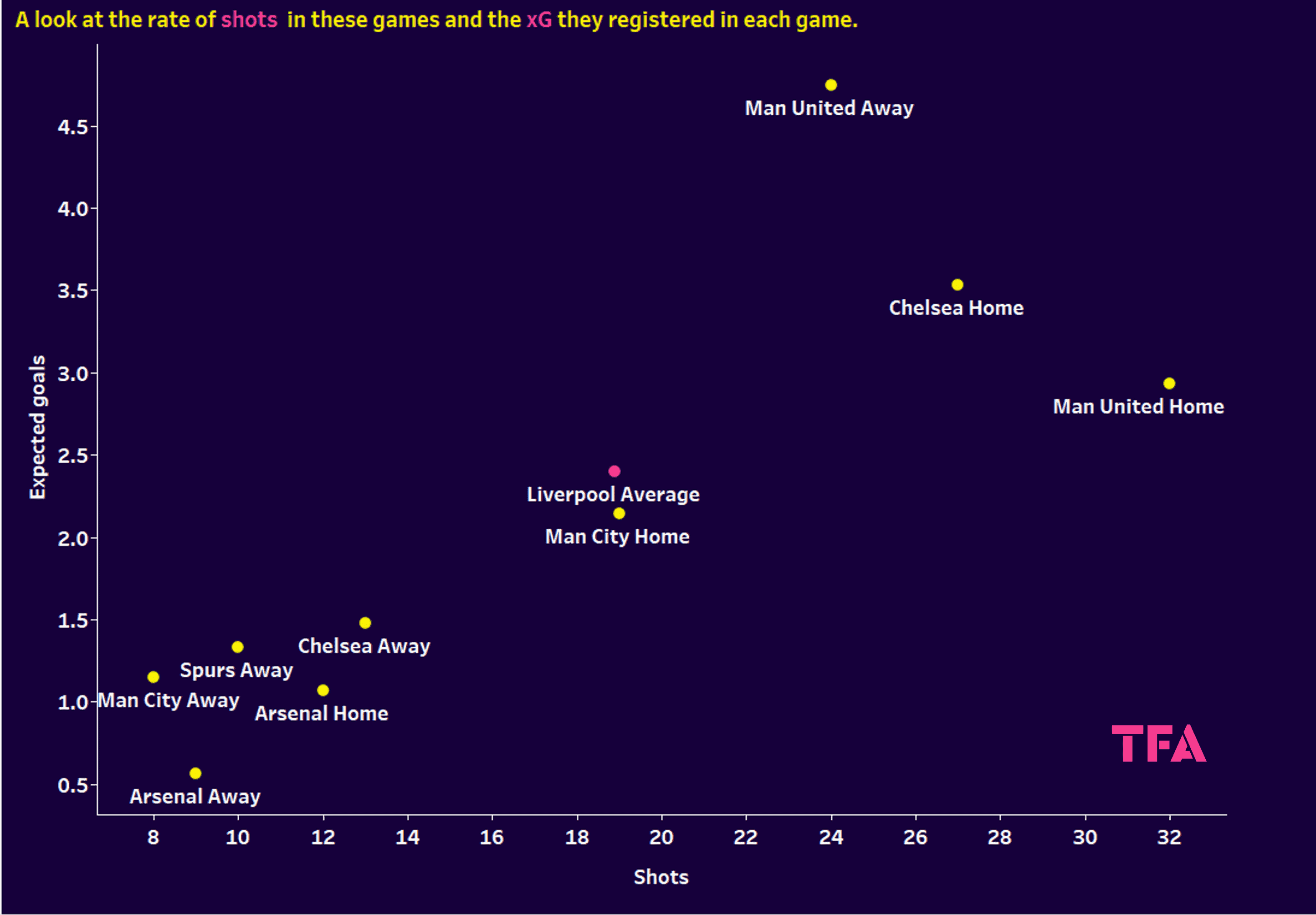
Low possession doesn’t always equal poor performance – we all know that. It can often be the result of a tactical direction being taken for specific games/scenarios, but with Liverpool, it sometimes seems to be a mixture of the two. Their activity in front of goal is a bigger indicator of how they cope with an opponent – regardless of what tactical approach Klopp opts for, his teams are usually dangerous in the final third.
Despite racking up plenty of shots on goal against Manchester United in both fixtures this season, Liverpool have failed to beat their big rivals on both occasions despite firing 56 attempts on goal across the two games, facing just 10 shots from United. Of course, there is the opportunity to go into each of these games and analyse them on a tactical basis, but the aim of this article is to provide insight into Liverpool’s struggle in big games and, if they occur, highlight any patterns.
Away fixtures against the big sides appear to be a big problem for the Anfield club—understandably so, but you’d expect a team of Liverpool’s quality to be more successful on the road. This season, they average 18.88 shots per 90 minutes, with an xG rate of 2.4 per 90 minutes. Of the nine games, they failed to meet both numbers in five fixtures—four away from home.
Interestingly, Arsenal is the only club of the big six that can keep Liverpool at bay for over two games in terms of facing a high number of shots and xG.
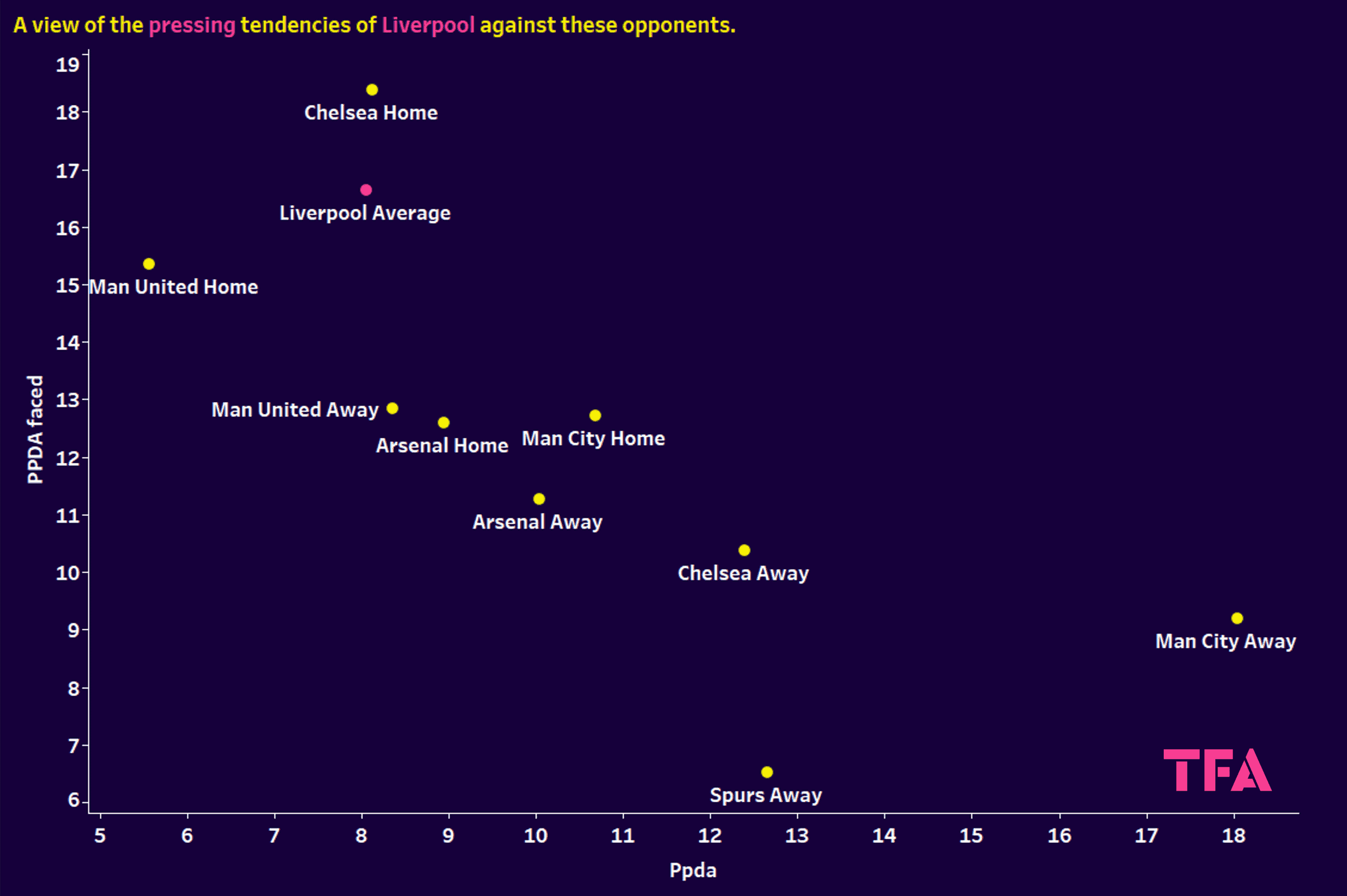
Liverpool under Klopp are famous for their high energy, intensity, and aggression, especially off the ball. They often employ tactics that centre around pressing the opponent high up the pitch. Their average PPDA of 8.06 is a strong indicator of this.
However, according to the data, they fail to maintain such intensity in these big games. Only the home fixture against Manchester United saw Liverpool gain a lower PPDA rating than their league average. However, the away fixture at Manchester City and the home game against Chelsea were close to the average figure. All games aside, that one saw Liverpool perform less aggressively off the ball than they tend to do from week to week.
This graph also shows you the PPDA Liverpool faced in these games, i.e. the PPDA of the opposition against the Reds – for further context. In particular, Tottenham and Manchester City at their own grounds gave Liverpool a taste of their own medicine in terms of pressing often.
Lower possession & aggression
As we just touched on, Liverpool have gone through some of these games, opting to be more defensively reserved, straying away from their usual high-intensity approach. This segment of the data analysis looks at match-specific data to give you an idea of what we mean.
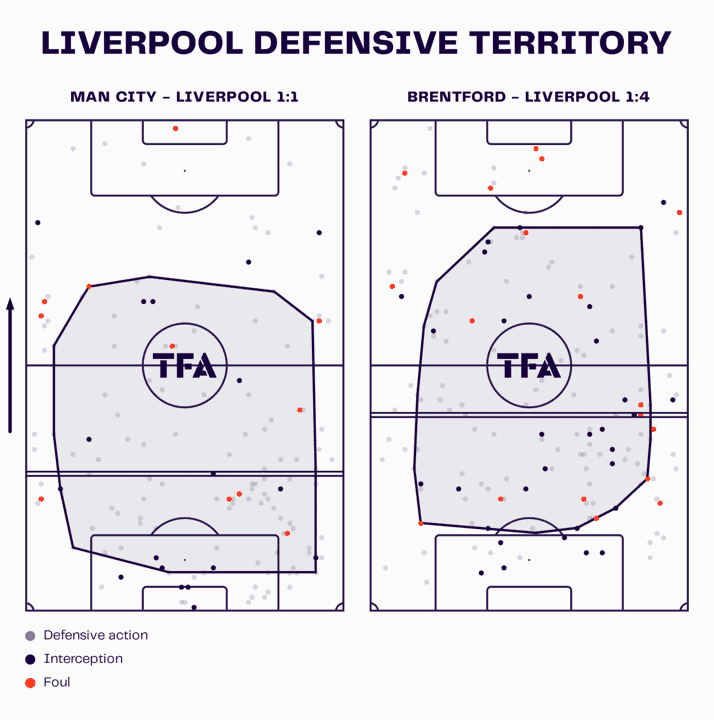
As you can see, we have Liverpool’s defensive territories against Manchester City and Brentford (we picked the Brentford game as Liverpool registered a high PPDA in this fixture). Now, we know that playing Manchester City, whether home or away, comes with different challenges than playing a side outside of the big six, but the aim here is to illustrate part of that different challenge and why/how Liverpool are struggling to adapt.
There are some glaring differences in the two performances regarding Liverpool’s defensive territory and action. Firstly, their general defensive line against City was considerably lower, allowing more opposition activity in their own half and defensive third. Additionally, they were far less defensively active in the opposition half vs Manchester City.
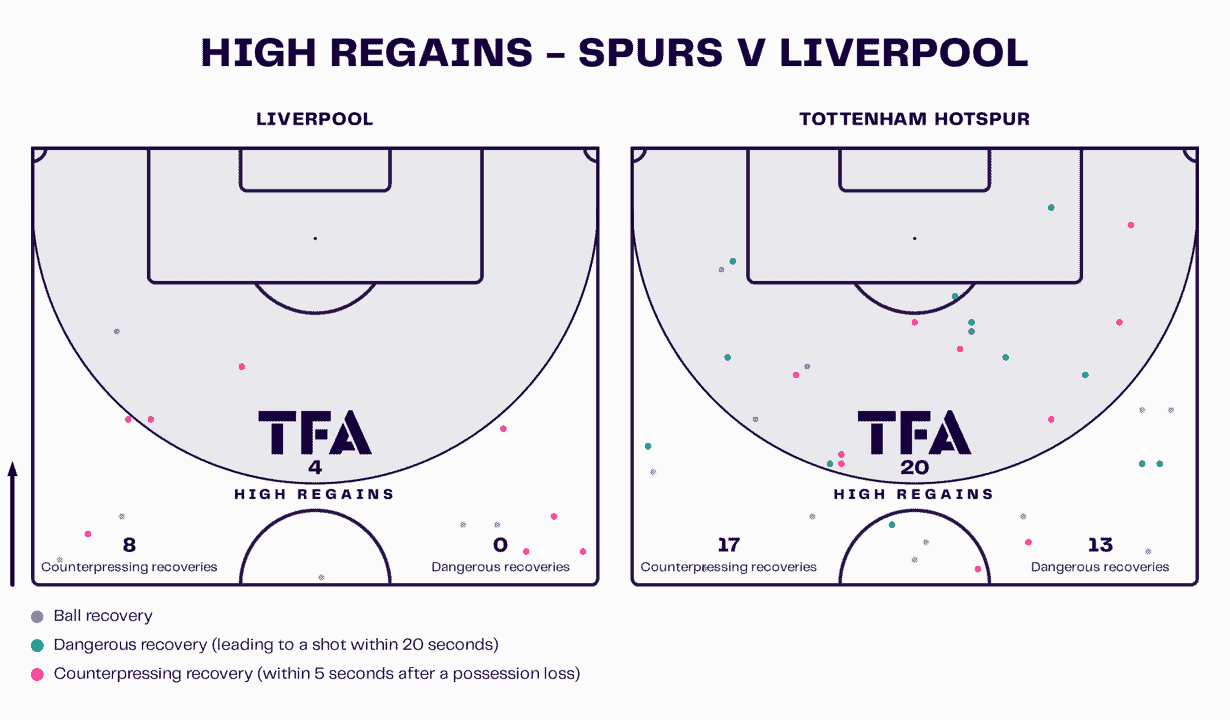
That lack of defensive activity in the opposition half was not a one-off vs City – as their data against Spurs shows us. While this game was marred with controversy involving the match officials, the performance itself from Liverpool was out of nature for what we’re used to from them. As we saw earlier, they recorded low possession, fewer shots than usual, and were far less aggressive out of possession, too.
Spurs, on the other hand, showed more traits of a high-intensity team in this fixture, bettering Liverpool when it came to the number of counterpressing recoveries made – the same can be said for the number of high regains and dangerous recoveries; Liverpool really weren’t on top of their game in that respect, as the data tells us.
Not taking chances
Not every one of these nine games has been a poor performance from Liverpool. There have been games where they’ve had less possession than they’re used to but created chances of high quality/frequency and games where they’ve dominated the ball but not found the back of the net, which leads us to an important point about Liverpool’s season—missing too many chances.
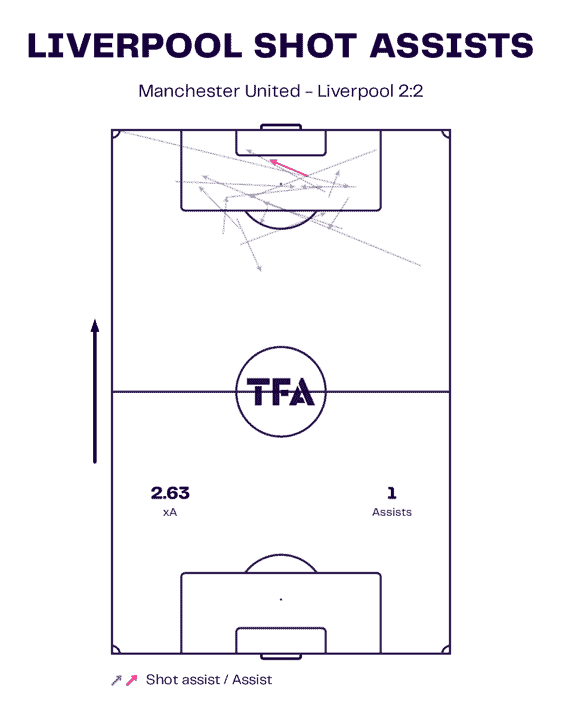
As we saw earlier, Liverpool’s 2-2 draw with Manchester United was dominated by Klopp’s team: 59.63% possession, 4.75 xG from 24 shots, but still couldn’t put their opponents to bed. Yes, they scored twice, but the numbers alone suggest they would be outscoring their opponent on the day. What we’re seeing here is a prime example of why you can’t judge football on data alone – but it can provide important insight.
Liverpool created a good number of chances in this fixture, mainly focusing their play through central areas, as the map above shows. They racking up an xA of 2.63. When their goal tally falls below the numbers for both xG and xA, you have to chalk that down to failure to take chances.
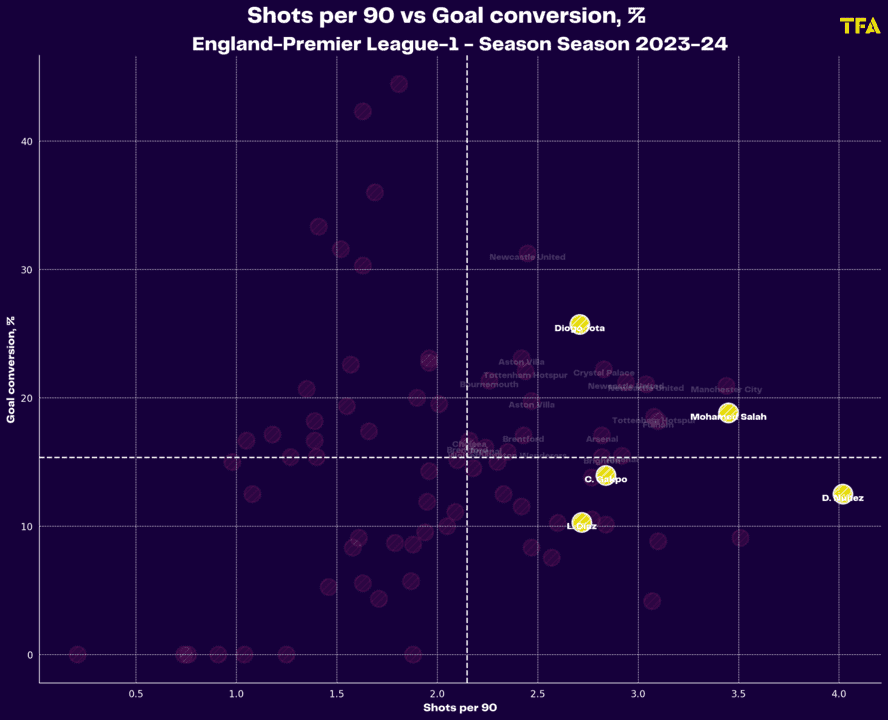
Darwin Núñez has been criticised heavily this season for his tendency to miss big chances. While the forward does contribute a terrific G/A for this side—his goal tally should be higher—he isn’t the only one missing important chances. Recently, we saw Curtis Jones miss what looked to be a certain goal in Liverpool’s defeat to Crystal Palace, and there are other instances of Reds players missing big chances in important moments this season.
Of Liverpool’s five forwards, while they all rank higher than average in the EPL (in comparison to other CFs and wingers), only Diogo Jota and Mo Salah rank above the league average for goal conversion %, with Núñez, Cody Gakpo, and Luis Días all ranking below that line. In a nutshell, those three have plenty of shots but don’t put enough of them away.
Based on that data, there is an argument for Jota being Liverpool’s first-choice forward, but Núñez undoubtedly has qualities that his team benefits from, and the chaotic presence he brings up front can be hard to defend against.
Conclusion
The aim here wasn’t to solve Liverpool’s issue of beating the big six – if it was that simple, Klopp and his team would’ve had it nailed a long time ago! Football is a game that contains multiple layers of complex tactical and environmental factors, and the bottom line is that Liverpool’s consistent struggle against the big six has hampered their title bid and could even end up being a significant factor in Klopp not landing the title again before his departure. They have one final game against a ‘big six’ side when they face Spurs on the 5th






Comments